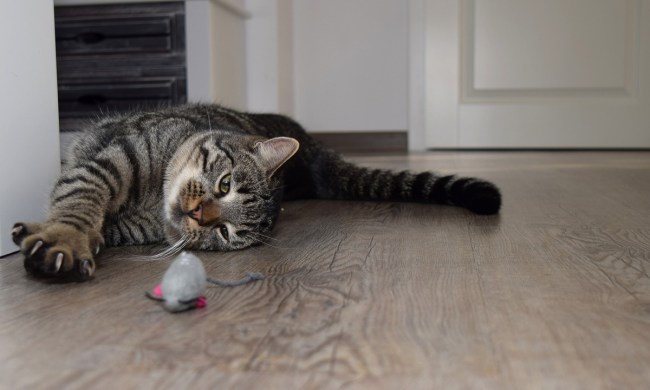It’s essential to feed your cat a nutritionally complete diet, but you have a lot more leeway when it comes to cat treats. Meals should make up most of your feline friend’s diet, so the treats you choose don’t have to be as nutritious and filling. Treats are for enjoyment and rewards! Many human foods are safe to share with your cat as treats and some are toxic, but it can be hard to remember what’s on the list.
If you’ve ever wondered, “Can cats eat apples?” you’re not alone. After all, fresh fruits are an essential component of a balanced diet for people, so is it the same for cats? Let’s find out!
Can cats eat apples?

Apples are a safe and delicious snack for cats to eat on occasion. The flesh of the apple can be hydrating, refreshing, and tasty, though the skin of the fruit can be fibrous and challenging to chew. However, the apple’s stem, leaves, and seeds all contain trace amounts of cyanide, which can make small animals sick. Even though a cat would have to eat lots of apple seeds and stems to consume a fatal level of the poison, a small amount can still cause stomach upset and digestive issues.
If you have an outdoor cat and an apple tree in your yard, it’s essential to pick up fallen fruit before your kitty does. While a few bites of apple are unlikely to cause illness in healthy cats, unsupervised snacking has the potential to cause problems.
Are apples good for cats?

While apples are safe for cats to eat occasionally, they aren’t very nutritious for our feline friends. For this reason, you should only they offer them as a treat. Cats are carnivores, and most of their nutrients should come from meat-based products. Although apples contain vitamins, minerals, and antioxidants that are beneficial for humans, cats don’t digest these nutrients well since their systems are designed to absorb nutrients primarily from meat.
Feeding apples to cats may come with more risks than benefits. Their high fiber content can lead to temporary digestive upset in sensitive cats, while the high sugar content can cause spikes in blood sugar and even pancreatitis complications. Additionally, over time, the sugar in apples can also negatively affect the health of cats that are diabetic or overweight. This is why moderation is key and why you should always consult your cat’s veterinarian before adding a new food to their diet.
Apple products that cats should not have

Apples may be safe to feed to cats in moderation, but we can’t say the same for all apple products. Dried or dehydrated apples, for example, contain even more sugar than fresh apples due to the fruit’s lack of water. While they aren’t toxic for cats, they are even more likely to cause blood sugar spikes and obesity over time.
Instead of drying apples before feeding them to your cat, try cooking them. Cooked apple flesh can be easier for cats to chew and digest, though be sure to watch out for extra ingredients in the cooking process. Apples baked with cinnamon and sugar may be delicious for us, but the not-so-healthy ingredients will do more harm than good for your feline friend.
Similarly, never feed your cat caramel apples or candied apples coated in chocolate or sugar. Doing so would be asking for trouble! Not only is chocolate toxic to cats and dogs, but sugary ingredients are sure to cause digestive upset, at least.
Even apple juice, apple cider, and applesauce can have a sugar content high enough to cause problems, especially when they’re store-bought items. Homemade apple products may contain less sugar and fewer additives that would harm your cat, but even these should be shared sparingly.
How to feed apples to cats

If your cat shows interest in the apple you’re slicing, it’s perfectly OK to offer them a small bite. Be sure to wash your apple and core it as well as remove the seeds and stem. Cut the apple into small, quarter-inch-long cubes, and let them try one. If they are not a fan, that’s fine. Apples are not essential to any cat’s diet, so they won’t be missing out on anything important.
Alternatively, if your cat does enjoy their first bite of apple, consider cooking it slightly (with no additives, please!) to make it easier to chew and digest. Don’t exceed more than one or two bites of apple per week, especially when they’re first trying it, or else you risk digestive symptoms like gas and diarrhea.
There are plenty of other fresh ingredients for your cat to savor while you’re cooking, including the meat products that are so important to their health. Apples aren’t worth stressing over, but if your cat wants to try a bite, why not?




